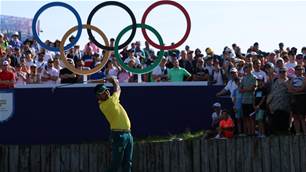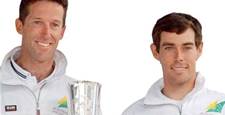Team chemistry’s one of those unpredictable sciences which can blow-up in the faces of even the biggest names in sport
Team chemistry’s one of those unpredictable sciences which can blow-up in the faces of even the biggest names in sport
 Malcolm Page (left) and Mat Belcher (right)
Malcolm Page (left) and Mat Belcher (right)Image: Courtesy Victor Kovalenko.
(exhibit A: the NSW Blues of recent campaigns – when will they get it right?). For Malcolm Page and Mat Belcher, though, it’s an occult art they’ve mastered since teaming up in 2008. What Page (below left), the Beijing gold-medallist and four-time world champion, doesn’t know about the 470 (4.7m long) rockets isn’t worth knowing. Belcher’s just about proven himself on the water, too; he was an Australian Sailor of the Year finalist for 2006-07, winning Aussie National Championship gold around the same time.Page, 38, and 28-year-old Belcher have dominated the world of 470 class racing of late, destroying all who dare take them on in the category which has been an Olympic sailing staple since 1976. They’re currently the number-one ranked (by the International Sailing Federation) Men’s 470 pair on the planet, having claimed this year’s 470 World Champs and World Cup, and were leading candidates for the Rolex World Sailor of the Year awards being hosted by Greece in November.Inside Sportcaught up with the duo during a recent training stint at Sydney’s Middle Harbour Yacht Club, where they were already plotting their path to London 2010 gold
STARTING OUT
MAT BELCHER: “We’ve been racing together since November 2008. When we teamed up, I’d been sailing 470s for seven years, since 2001, and Mal since 1997. I first sailed when I was six or seven in a very small boat in a junior class.
I’ve been on the water for 20 years now.”
MALCOLM PAGE: “I’ve been sailing for 30 years in total. I was eight when I started. I came from a non-sailing family, which I suppose isn’t normal around the waterways.”
470 WHAT?
BELCHER: “The 470 is an Olympic class of sailing. It’s a double-handed – or two-person – class. In fact, it’s the most popular double-handed yacht at the Olympic level. “The ‘470’ just means the yacht is 4.7m long. The Australian system is very fortunate to a have a very good head coach, Victor Kovalenko. We’ve had great success at Olympic level lately; at Sydney and Beijing our men and women won Olympic gold.”
PAGE: “Normally a 470 race is about an hour long, with the courses more or less up and back. At the Olympics, the top ten boats will contest the medal race [or 11th race], which is shorter in time, maybe about 30 minutes long. Each category of race boat requires an ideal sailor body shape for top performance – Mat and I fit the 470 mould perfectly; we’re tall and lanky. I’m the trapeze – a skinny build makes for easier leverage and movement around the boat. Mat is shorter and can really muster the boat around from inside.”
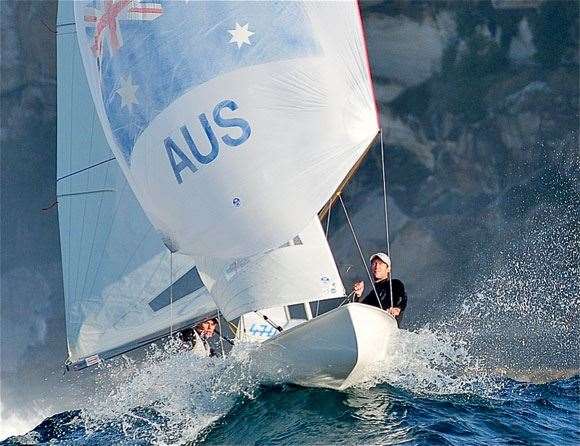 The 470 is an Olympic class of sailing. Images: Courtesy Victor Kovalenko
The 470 is an Olympic class of sailing. Images: Courtesy Victor KovalenkoYEAR IN, YEAR OUT
PAGE: “It depends on the year as to what events we’ll give priority. Obviously this year, for example, we put huge focus on the World Championships, which is our number-one regatta outside the Olympics, and the accompanying Olympic Test Event. The latter gives us a chance to remind the world they’re vying for second! The next most important series would be the World Cup, which is a series of seven regattas. We’re also always out to win a major regatta in Europe; that’s where all the top guys are and we’re keen to show them what we’re worth.”
BUSY WEEK
BELCHER: “Our preparation is very camp-based. There are a few limitations for us because of where we live. I’m based on the Gold Coast and Malcolm lives in Sydney, so we’re always trying to make the most of our training time when we’re together. We also situate ourselves depending on where the next World Cup eventis. No week is ‘normal’, as such. At the moment we’re doing four days on, one day off. So we train, on average, five or six days a week.”
PAGE: “We’re out on the water in the yacht twice a day, which we find gives us a bigger wind range to work in. Say, a light wind in the morning and a good sea breeze in the afternoon. We’re talking about a 9am launch, through to midday, and we’re normally back out on the water again at 2 or 2.30pm for another two and a half hours. Keeping the sessions shorter, we find our practice is more effective than having one long session, where our concentration may suffer.”
FIGHTING FIT
BELCHER: “We’re quite restricted as to what weight we can carry – for obvious reasons. Mine is somewhere between 63-65kg. Mal’s is probably about 10kgs more. There’s no weigh-in for a race, it’s not essential to be 2kg lighter – you won’t be disqualified or anything. We get fitness tested twice a year by the AIS, so we have standards we have to meet in terms of strength and endurance. I’m into running; I’ll try to cover between 30 and 40km a week. We also have set exercises we do, mainly for the core: things like Superman vees. I’m using the Swiss Ball quite a lot at the moment. That’s more to simulate the muscle work required during a race.”
PAGE: “We have independent fitness regimes because our needs and ages are a little different. I’m a terrible runner. I’m built for running, but I find it hurts my body because of my back problems. Sailing’s number-one injury complaint is back issues. Like Mat, my normal day would be working on my core stability, my shoulder stability. I normally do plenty of cardio work. Because we travel so much, I like to always have an option other than gyms, which are sometimes hard to find. My cardio is based around the bike because it’s low-impact on the body. It depends on our position in our program, how tired I am, but I’ll try and fit at least something in every day.“Straight after the Beijing Games I went a bit slack and wasn’t as diligent with my core work as I should’ve been. At the World Champs in 2009 I was in immense pain. It was warning of what happens when you take your mind off the game. But now, a year later, I almost have no such problems. Sailing has become more and more physical as it’s evolved over the years.”
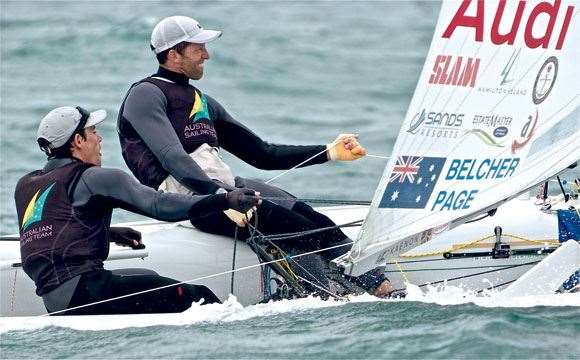 A boat in every port..
A boat in every port..Images: Courtesy Victor Kovalenko
A BOAT IN EVERY PORT
BELCHER: “We have a few competition yachts scattered throughout the world. We have one in Europe – where a lot of the World Cup events are held. We’ve had one shipped to Miami, we had another shipped to Perth and we have two
in Sydney.”
PAGE: “Yachts aren’t something you can fly around the world. Logistically it’s a tricky sport to handle; we find it’s easier to have equipment waiting for us around the place, so we can step straight into the boats when we arrive.”
WATER WORK
BELCHER: “At the moment, because we have sail designers here, we’re doing a lot of equipment and sail-testing. At other times we might be concentrating on skills/boat handling; things like manoeuvring around buoys, or boat-on-boat testing with another yacht to develop our race judgement.”
PAGE: “We’re currently spending hours and hours on what we call straight-lining, where we’ll just be on the one tack for sometimes up to an hour against our training partners, looking for an inch advantage while steering the boat. When we’re training overseas, we try and pick out 10-15 high-quality competitors to race us in short course practice. We’ll work on things like our starts, manoeuvring into position and utilising the wind to our advantage.”
TALENT VS TECHNOLOGY
BELCHER: “The good thing about 470s is that every boat is quite similar in make – the equipment onboard is very heavily regulated. The boats are made by licensed builders and the tolerances are very small. This stops someone having a massive speed and equipment advantage over someone else. There’s very little difference between one 470 boat and another.”
PAGE: “In 470 racing, results are 80-90 per cent dependent on the performance of the athlete. At Olympic level, sure, you must have adequate equipment with you, but the skill level will always shine through over some minor equipment advantage because the rules are so tight.”
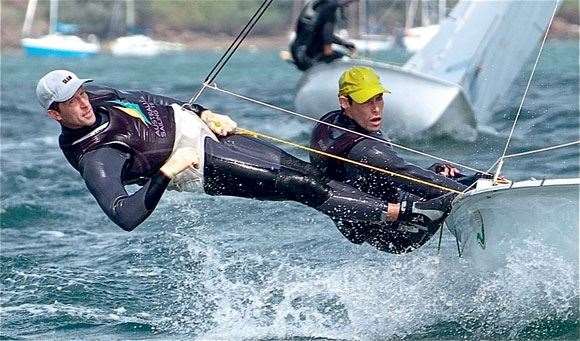 "Sailing has become more and more physical as it’s evolved over the years.”
"Sailing has become more and more physical as it’s evolved over the years.”Images: Courtesy Victor Kovalenk
THANKS, COACH
BELCHER: “Succeeding at an elite 470 level would be impossible without a coach. Having ten boats on the course, there are so many different elements – wave patterns, rig set-ups, wind directions, whether the wind is shifting a lot, the temperature of the breeze, the currents – which a coach can deliver advice on in between races.”
PAGE: “No electronic communication with coaches is allowed during races. Having the guidance of someone like our Ukrainian coach Victor, making sure our time with him is as effective as possible is the key. He’s certainly our training program manager. He’s our third set of eyes, too. Because he’s outside the boat, he gets to see a lot more than we do. He has some weird and wonderful ‘Victorisms’, as we’ll call them. Coming from Eastern Europe, the culture differences
13 years ago were grand, but we’re much closer now. I reckon he’s been very Aussie-fied.”
WHO’S THE BOSS?
BELCHER: “There’s a ‘captain’ depending on the situation in a race, or what position we’re in. We have set roles, like in pre-start, etc. We’re probably at that situation where we have that unspoken way of communicating. The more time you spend with someone, the more you know what’s going to happen next. You pick up on feelings, techniques.”
PAGE: “We spent so many years sailing in this class before we teamed up, we just basically slapped stuff together
and for our first nine-odd months as a team, while we were performing very well, we were in the top six in the world, but we weren’t cracking the top three. Working out our communication is one of our ongoing main focuses. Certainly one person is a boss at a particular moment ... ”
TALKING TACTICS
PAGE: “Ideally, most of our conversation during a race will centre around tactics. We like to talk the scenarios out before we get to that crunch time where we have to ‘flick the switch’. So, when we get out there, and the scenario has been dealt to us, we’ve already worked out what the answer will be: if it’s ‘one’ we do this, if it’s ‘two’ we do that. Sometimes it takes 30 seconds to have that conversation, sometimes a situation might only give us five seconds of lead-up time.”
BELCHER: “In a decision on whether to tack, there could be another 30 boats all mixed in together and the reason why you would tack might be because there’s more or less current on the other side of the course. Or you might think the breeze is going to shift and want to take the advantage. Alternatively, you can try to cross or duck. A lot of our communication mid-race is about positioning the boat where we think the wind will shoot next.”
– James Smith
Related Articles
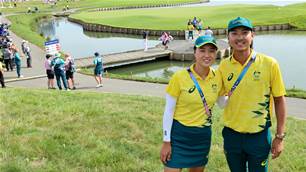
Min Woo backs Minjee to win the medal that eluded him

Playing From The Tips Ep.75: Women's Olympics, Wyndham & more
